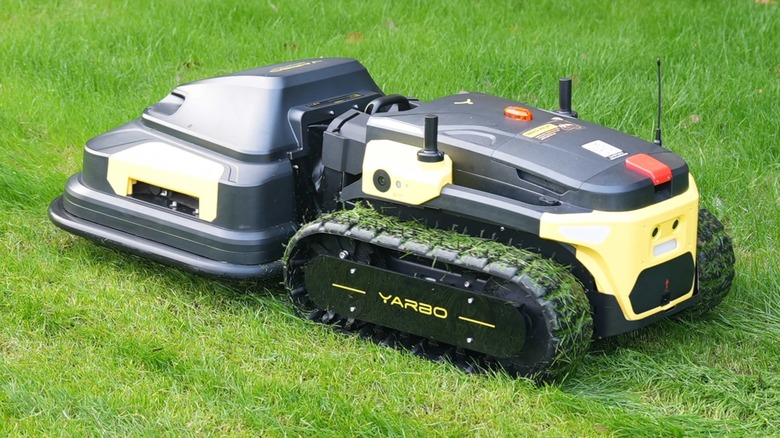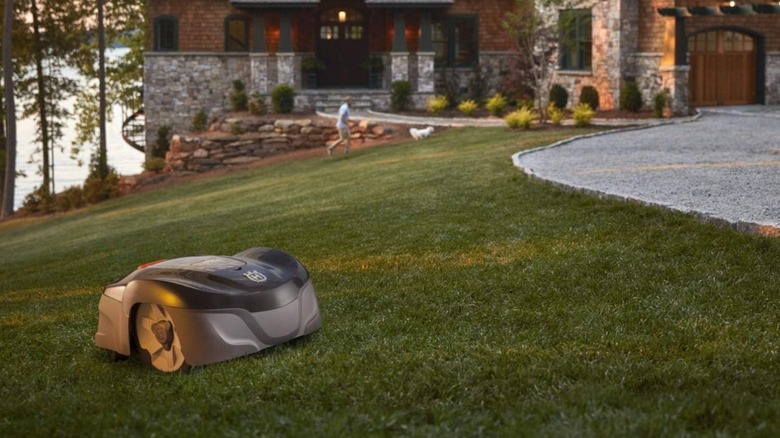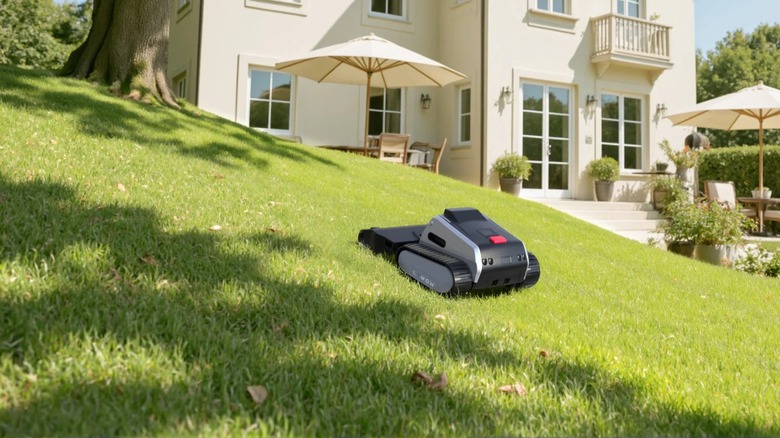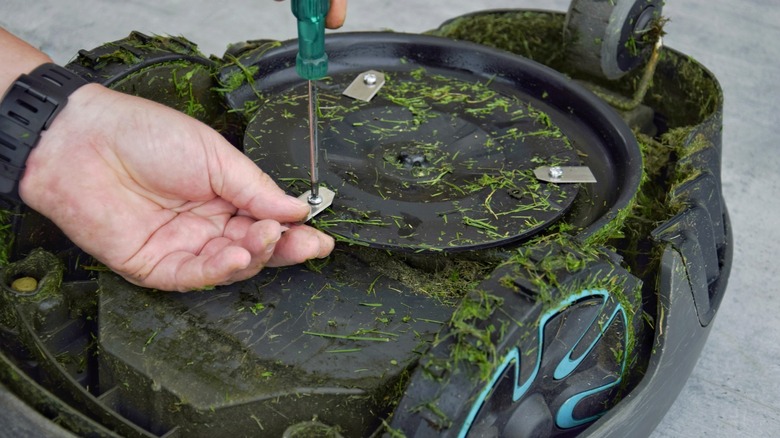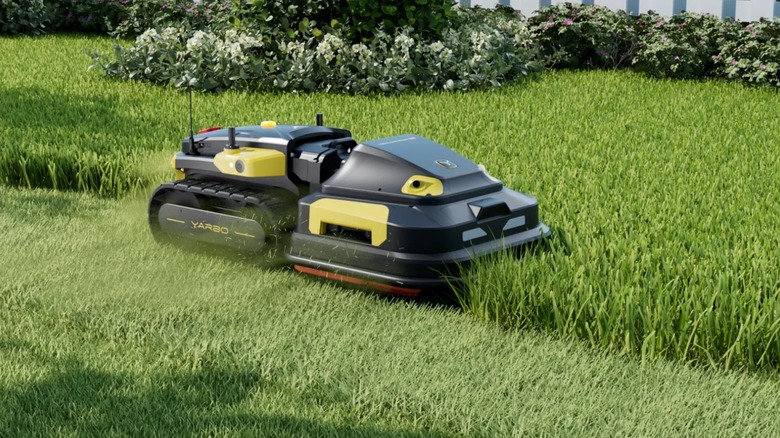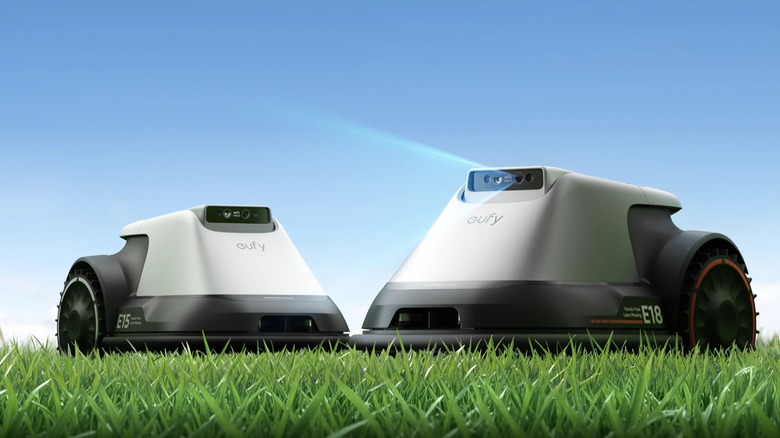5 Things To Know Before Buying A Robotic Lawn Mower
We may receive a commission on purchases made from links.
While robot vacuums like the Roomba once seemed futuristic, for many people, they've since become as commonplace to own as refrigerators and microwaves. Robotic lawn mowers may be on the same trajectory, as they've already gone from futuristic sci-fi prototypes to accessible, functional yard equipment. Every year, more homeowners are abandoning traditional push and riding mowers in favor of robotic models. You may already be considering doing the same — perhaps after seeing a neighbor kick back on their porch as a robotic landscaper handles the lawn without breaking a sweat.
Robot lawn mowers are battery-powered, self-propelling, self-navigating grass cutters. Unfortunately, they're still pretty pricey. Since you'd likely be investing a significant chunk of change, you'll want to know everything you can about selecting a robotic lawn mower, as well as what to expect when you own and use one.
The last thing you want to do is spend money on a device that isn't suitable for your property, or find out that, for whatever reason, robotic lawn mowers in general just aren't for you. Here are five things you should know before buying a robotic lawn mower, and what to consider when choosing the right one for your yard.
You'll need to set a boundary for your mower
There is a wide range of robot vacuums to choose from these days, and many function in different ways. Some will roam around before returning to their base to recharge, while smarter models can map your home and follow selected paths. Robotic lawn mowers are slightly different because they require boundaries. Mower blades can do a lot more damage than the brushes of a vacuum, so it's important that they don't stray out of your yard and into flower beds, children's play areas, or a neighbor's lawn.
Many robot mowers require you to lay down physical wires or sensors around your property to keep the mower from going too far out. This setup can take several hours. You may even bury the wire underground to protect it and keep it from accidentally moving — a step that adds even more time to the setup.
You can find newer models that, instead of requiring physical boundaries, rely on GPS to navigate your property. This is still more involved than how most robot vacuums make their way around your home, and these GPS-enabled mowers are typically more expensive. One model produced by Husqvarna — which happens to be one of the best lawn mower brands – is the Automower 435 iQ AWD. It uses multiple satellites to obtain precise location data. This would save you a lot of setup time and boundary maintenance, but it comes with a hefty $5,000 price tag.
Your yard may not be suitable for all mowers
Not all yards are suitable for all robotic mowers, so make sure the one you buy can actually handle your property. Two main things to consider are the size of your lawn and how steep any slopes in the terrain are. You may be thinking about switching to a robot mower because traditional models are too physically demanding, especially if you need to push one up hills and maintain control as you steer it back down. Robotic mowers can be very useful by saving you this labor, but only if you choose one that can handle your lawn's incline. The Gardena Sileno Minimo, for instance, is limited to a 35% gradient (19 degrees), whereas the Ecovacs Goat A2500 RTK can climb 50% slopes (27 degrees). The Lymow One can even ascend 100% slopes at a 45-degree incline.
The size of your lawn is slightly less important when choosing a mower, but still worth considering. Robotic lawn mowers are battery-powered, so one of the biggest factors that affects their range is their battery life. Mowers with smaller-capacity batteries or reputations for poor efficiency may not be able to mow your entire lawn in one go. This isn't the end of the world, since they can go back to their dock, recharge, and finish the rest, but this also means that it will take more time.
Some of the most important metrics to consider when buying a robot mower include its slope capability and battery life. If you've got a relatively small and flat piece of property, you can likely save money by getting a mower that's limited in these aspects but still generally good overall.
Many robotic mowers don't use bags
A common debate among landscapers is whether or not mulching mowers are worth using over bag or discharge mowers. Bag mowers collect grass trimmings for you to later dispose of, while discharge mowers eject the clippings back onto the lawn, usually from a side chute. Mulching mowers, on the other hand, finely chop blades of grass over and over before finally depositing them back to the ground. Not only does this save you the time and effort of throwing out or composting bags of grass, but the trimmings act as a layer of natural mulch.
This mulch can be very beneficial to your lawn, improving water retention and soil health, as well as acting as fertilizer for your grass. However, not everyone wants to leave this mulch where it lies. For some, the messy look of leaving your trimmings on the lawn defeats the purpose of cutting it and keeping it well-maintained in the first place. The mulched grass can also clump, especially when wet. You're also likely to track it on your shoes and possibly into your home when you walk through it. Lastly, it can foster the growth of annoying insects and other lawn pests.
If you prefer to throw out your grass debris rather than keep it, a robot mower isn't a good choice for you. Most robotic mowers don't carry bags and collect yard waste, so if you want a machine to do the cutting for you, you'll have to either leave the clippings or collect them yourself. For what it's worth, if you use the robotic mower often, the clippings will be fairly short and less noticeable. Some robotic mowers have bags, but they're a small minority.
Cutting width matters more than you think
Robotic lawn mowers vary by model in aspects such as cutting height and width, and some allow you to adjust both. The width affects how many passes it will take to cut your entire lawn. Smaller cutting widths mean the mower will take longer to finish, which could be a deciding factor in which model you end up buying.
Beyond that, the faster the mower can cut your lawn, the less battery it uses up. Over time, if you cut your lawn regularly, you'll get more life and more cuts out of its battery, saving both time and money. Some robot mowers have incredible range — for instance, the Yarbo Mower Pro can cover up to six acres. If that's important to you, consider a mower's cutting width as much as its battery life.
This is also why it's important to choose a robotic mower that's best suited for the size of your lawn. Some are built for small yards, while others are made for the large plots of land you may traditionally use a riding mower for.
Robot mowers are still evolving
Traditional lawn mowers are more or less the same as they were 30 years ago. The only real change has been the improved efficiency battery-powered push mowers. Robotic mowers, however, are still fairly new to the market and are continuing to evolve — sometimes in leaps and bounds. Competing brands are constantly adding innovative features and refining others, with new products like Eufy's E15 and E18 robot lawn mowers paving the way.
Because of this, shopping for a robot mower can feel more like buying a smartphone than a traditional lawn mower. You might spend hundreds, if not thousands of dollars on a premium robot mower, only for a newer and better one to come out just a few months later. After just a year or two, your mower may even seem obsolete compared to more modern ones.
You'll find some users warning of this dilemma in online discussions about robot lawn mowers, with some saying they want to wait for solar-powered options. Others comment that they're holding off on making the switch to robotic lawn mowers until prices in general come down, which is something that often occurs when a technology becomes more widespread and efficiently manufactured. When this happens, you may see robot mowers all over the neighborhood, just as once-rare and expensive robot vacuums have become common household appliances.
